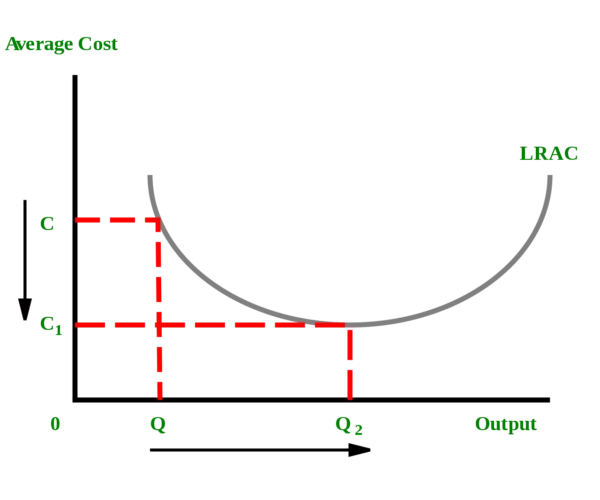Economies of Scale: Definition, Types & Examples

Economies of Scale Definition
Economies of scale occur when a business benefits from the size of its operation. As a company gets bigger, it benefits from a number of efficiencies. For example, it’s far cheaper and efficient to serve 1,000 customers at a restaurant than one. You have staff costs, the cost of rent for the land, and perhaps any advertisement costs. As a business, you don’t want to be paying staff to sit idle, nor pay thousands in rent just to serve one customer.
As a company grows, its unit costs decrease. In other words, it costs less to produce an additional good or service. This is because the business starts to benefit from several types of efficiencies such as financial, technical, government influence, or infrastructural – among many more.
Key Points
- Economies of scale refer to the lowering of per unit costs as a firm grows bigger.
- Examples of economies of scale include: increased purchasing power, network economies, technical, financial, and infrastructural.
- When a firm grows too large, it can suffer from the opposite – diseconomies of scale. This is where unit costs start become more expensive, due to increasing size.
An important part of economies of scale to understand are fixed costs. These can take up a significant part of a business’s expenditures. For example, the airline industry has significant fixed costs. It must pay for the airplane, the hire of the airport, and contracted salaries. Its costs are the same whether it has one passenger or 200. So when an airline grows bigger, it is able to attract more customers and thereby reduce the cost per customer.
For example, an airline may invest $20 million into a new airplane. If it serves one customer, it must charge $20 million to recoup its costs. However, if it serves 1 million customers, it only needs to charge $20.
If we take another example. Businesses benefit from economies of scale when long-run average costs fall as production levels rise. Lower unit prices occur as a result. For example, a factory will be able to produce 1,000 cans of tuna at a far lower price per can than one. So in short – the more a business produces, the lower it costs them, and in turn, the lower it can charge customers.
Examples of Economies of Scale
There are two main types of Economies of Scale – they are internal and external. Internal economies of scale refer to benefits that occur within the firm. For example, the firm may be able to obtain higher levels of credit due to its size.
By contrast, external economies occur outside of the firm, but inside the industry, that makes them more efficient. For example, the government may create a new regulation that affects not only the industry as a whole but also the individual company. This may be due to the increasing size of the industry which attracts regulatory attention. For instance, internet-based taxi companies such as Uber are facing regulatory action as a result of its rapid rise in popularity.
Internal Economies of Scale Examples
Internal economies of scale measure how productive and efficient a firm is. In other words, how the firm benefits from more ideas, a greater division of labor, or perhaps financially. Essentially, anything that the firm has direct control over. Examples of internal economies of scale include:
- Financial Economies of Scale
- Network Economies of Scale
- Purchasing Economies of Scale
- Division of Labor
- Technical Economies of Scale

1. Financial Economies of Scale
Large firms can benefit from superior interest rates and credit availability. For instance, banks offer more favorable rates to big firms such as Walmart or Amazon, because the risk is significantly lower. For example, a new local restaurant is more likely to fail than a McDonald’s store – so they are afforded better rates to account for risk. At the same time, the actual availability of credit is much more accessible. So not only do big firms get better rates, but they have a wider number of financial institutions to choose from.
2. Network Economies of Scale
Network economies of scale is a relatively new concept, but it comes from the thought that as a company grows bigger, so too does its network. In turn, this makes it more attractive to new customers. If we look at Facebook, for example, its growing popularity made it a hit within social networks, making it grow exponentially. As it grew through networks, the amount it could charge for adverts equally grew.
3. Purchasing
As firms grow larger, they can benefit from buying in bulk and cheaper prices. For example, supermarkets can get vegetables and other supplies cheaper than a local market stall. They are able to use their strong position in the market to negotiate lower prices. As supermarkets like Walmart are big customers for independent farmers, they have a greater negotiating power over them.
4. Division of Labor
As a company gets larger, it can benefit from the division of labor. By allocating workers to specific tasks, they can do more effectively and efficiently. For example, Apple splits its operations down into design, hardware, software, manufacturing, marketing, production, and assembly.
Each employee has a different role that they specialize in. That allows them to master a specific skill, benefiting the company through greater efficiency. A software designer is not going to be much use producing the units, nor would a production worker be able to do the work of a software designer.
5. Technical Economies of Scale
Through the growth of the business, it can benefit from new production techniques and/or advanced equipment. An individual baker is unlikely to benefit from a production line of their cakes. However, should they become a big brand like Kipling, a more advanced production process would increase efficiencies.
External Economies of Scale Examples
External economies are slightly different from internal economies in the fact that they occur outside, independent of the firm, but within the industry. For example, the local council may build a new railway line, with local businesses benefiting from cheaper transport, and potentially a greater influx of new customers. Both of which may help reduce unit costs.
Examples of external economies of scale include:

1. Infrastructural Economies of Scale
This can come in the form of government or private investment. Firms will benefit from new roads, rail-lines, and schools in the local area. Equally, other firms may cluster in the same location – look at Silicon Valley for example. The surrounding firms benefit as they are able to access a strong pool of talent and knowledge – also known as Agglomeration economies.
2. Government Influence
As companies get larger, they are able to influence policy. Whether this is financial contributions like in the US, or just threatening close down factories. Thousands of jobs can be at risk, so governments can look favourably on their demands. Sometimes this could actually include greater regulation that creates further barriers to entry.
3. Suppliers
On occasion, a firms supplier may in fact move closer to the business. For some suppliers, their client becomes so large it is just more efficient to open a factory in close proximity. Coca-Cola for example operates a similar function with its bottle manufacturers who operate in close proximity due to the sheer demand. It, therefore, benefits the suppliers and the firm who both benefit from cheaper costs.
Economies of Scale Graph
As we can see from the graph below, the average cost to produce a unit decreases. However, when a business reaches a certain size, it can become less efficient – meaning the average cost to produce a unit increases.
For example, in extremely large and global businesses, there may be excessive amounts of bureaucracy. This can lead to less productive and inefficient workers. Workers may also become increasingly disengaged as management puts its efforts into other means, rather than managing the staff.

Some organizations become too big and lose sight of what is being spent. Layers and layers of organizational bureaucracy are put in place, making it inefficient for employees to do their job. At the same time, roles are split to benefit from the division of labor.
However, employees struggle to find the right person to contact out of the thousands of colleagues. In turn, we can see what is often referred to as ‘diseconomies of scale’, where businesses start to become more inefficient. This is where the Long-run average cost starts to increase again on the graph.
Advantages of Economies of Scale
There are many advantages of economies of scale that cover not only the firm’s perspective, but also that of the consumer. Some of these advantages include:
1. Reduced unit costs
The bigger a company becomes, the more customers it can serve – thereby allowing it to reduce costs per head. For example, companies with high fixed costs tend to benefit the most as these costs can be spread out per customer.
2. Higher profits
Economies of scale reduce the unit price and by extension, produce greater profit margins. As a firm gets bigger, it starts to sell to more customers. When combining lower costs and higher customer volumes – higher profits result.
3. Competitive Advantage
As a company grows larger, its presence in the market also increases. Customers start to become aware of its brand and develop trust in it – which allows the firm to establish its position in the market. It may also be afforded lower interest rates as well as greater availability of credit.
4. Influence over-regulation
As a business grows and increases its presence in the market, it hires more workers and becomes a more integral part of the economy. In turn, it is able to use this fact to lobby the government for regulatory change. For instance, it might be to leave the country because the regulatory costs are too high.
5. Lower prices
As the firm is able to reduce its average cost per unit – it can feed into lower prices for the consumer. Whilst some companies will take all the profits from increased efficiency – firms in a competitive market will pass on some of the cost savings to the customer.
6. New Products and Services
As a company grows larger, it often seeks to grow further. Now the best way of doing that is by extending its existing offering and attracting new customers – which leads to greater consumer choice.
7. Higher wages
In a competitive market, economies of scale can lead to growing wages as firms have lower costs. This is why big firms are able to afford higher salaries than local competitors. As the firm grows, production starts to become more efficient. In turn, they are able to offer higher wages than competitors to attract the top talent.
Disadvantages of Economies of Scale
There are several disadvantages that can occur due to economies of scale. We refer to these as ‘diseconomies of scale’ – which is where the firm becomes less efficient due to its increasing size. These can present several disadvantages such as:
1. Poor communication
When a firm grows, it sets up numerous departments for specific tasks. Now that may benefit the firm through the division of labor, but it makes communicating between teams difficult. For instance, who do you speak to if you have a problem with X. Often in such big companies, you are passed on and on and on again – taking, what should be an easy issue to resolve, significantly longer.
2. Loss of control
As the firm grows, management may go from having one or two delegates, to having 10 or 15 people working under them. It is far easier to monitor and assist a smaller team rather than keeping tabs on a large workforce. In turn, this can lead to some employees underperforming – either because they don’t receive adequate training, or, because their performance is not being monitored.
3. Poor morale
In small companies, there may be a nice community feel whereby everyone knows each other and are all friendly. When a company starts to grow, it is easy for employees to feel like they are ‘another cog in the wheel’. They are something small and insignificant in this large company – which can contribute to poor employee engagement and performance.
4. Tasks being repeated
When there are thousands of employees in one firm – it is very easy for two or more people to end up doing the same tasks. This is particularly prevalent when considering poor communication as a factor. When the left arm doesn’t know what the right is doing, it is easy enough for them to be doing the same thing.
5. Public opinion
A big company such as Nike or McDonald’s faces a bigger backlash from paying staff low wages or using cheap labor from abroad. On occasion, this has led to boycotts. Yet a small local store doing the same may not face such criticisms. Quite simply, bigger stores are held to a higher standard.
Related Topics
Economies of Scale FAQs
Economies of scale occur when a firm grows in size. An example of such are purchasing economies of scale. The firm benefits from being able to make bulk purchases at a lower price, thereby benefiting from lower costs.
Economies of scale are caused by firms growing to a size by which they are able to benefit from a number of efficiencies.
External economies are slightly different from internal in the fact that the occur outside, independently of the firm, but within the industry. So for example, the local council may build a new railway line. The local businesses may benefit from cheaper transport, and potentially a greater influx of new customers. Both of which may help reduce unit costs.
There are both Internal and External economies of scale. Examples include:
Internal:
1. Financial Economies
2. Network Economies
3. Purchasing
4. Division of Labor
5. Technical economies
External:
1. Infrastructure
2. Government influence
3. Suppliers
About Paul
Paul Boyce is an economics editor with over 10 years experience in the industry. Currently working as a consultant within the financial services sector, Paul is the CEO and chief editor of BoyceWire. He has written publications for FEE, the Mises Institute, and many others.

Further Reading
 Production Possibilities Frontier - The Production Possibilities Frontier (PPF) represents the different combinations of two goods an economy can produce given its resources and…
Production Possibilities Frontier - The Production Possibilities Frontier (PPF) represents the different combinations of two goods an economy can produce given its resources and…  Aggregate Demand: Definition, Components & Examples - Aggregate demand refers to all the goods produced and brought within the economy. Economists calculate this using values at a…
Aggregate Demand: Definition, Components & Examples - Aggregate demand refers to all the goods produced and brought within the economy. Economists calculate this using values at a…  Classified Balance Sheet - A classified balance sheet is a financial statement that categorizes a company's assets, liabilities, and equity into current and non-current…
Classified Balance Sheet - A classified balance sheet is a financial statement that categorizes a company's assets, liabilities, and equity into current and non-current… 